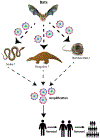Animal models for SARS-CoV-2 research: A comprehensive literature review
- PMID: 33128861
- PMCID: PMC8085186
- DOI: 10.1111/tbed.13907
Animal models for SARS-CoV-2 research: A comprehensive literature review
Abstract
Emerging and re-emerging viral diseases can create devastating effects on human lives and may also lead to economic crises. The ongoing COVID-19 pandemic due to the novel coronavirus (nCoV), severe acute respiratory syndrome coronavirus 2 (SARS-CoV-2), which originated in Wuhan, China, has caused a global public health emergency. To date, the molecular mechanism of transmission of SARS-CoV-2, its clinical manifestations and pathogenesis is not completely understood. The global scientific community has intensified its efforts in understanding the biology of SARS-CoV-2 for development of vaccines and therapeutic interventions to prevent the rapid spread of the virus and to control mortality and morbidity associated with COVID-19. To understand the pathophysiology of SARS-CoV-2, appropriate animal models that mimic the biology of human SARS-CoV-2 infection are urgently needed. In this review, we outline animal models that have been used to study previous human coronaviruses (HCoVs), including severe acute respiratory syndrome coronavirus (SARS-CoV) and middle east respiratory syndrome coronavirus (MERS-CoV). Importantly, we discuss models that are appropriate for SARS-CoV-2 as well as the advantages and disadvantages of various available methods.
Keywords: SARS-CoV-2; animal model; ferret; hamster; macaque; mice; pathophysiology.
© 2020 Wiley-VCH GmbH.
Conflict of interest statement
CONFLICTS OF INTERESTS
Authors declared no conflict of interest exists.
Figures


References
-
- Agostini ML, Andres EL, Sims AC, Graham RL, Sheahan TP, Lu X, Smith EC, Case JB, Feng JY, Jordan R, Ray AS, Cihlar T, Siegel D, Mackman RL, Clarke MO, Baric RS, & Denison MR (2018). Coronavirus susceptibility to the antiviral remdesivir (GS-5734) is mediated by the viral polymerase and the proofreading exoribonuclease. MBio, 9(2). 10.1128/mbio.00221-18. - DOI - PMC - PubMed
Publication types
MeSH terms
Grants and funding
LinkOut - more resources
Full Text Sources
Medical
Miscellaneous

